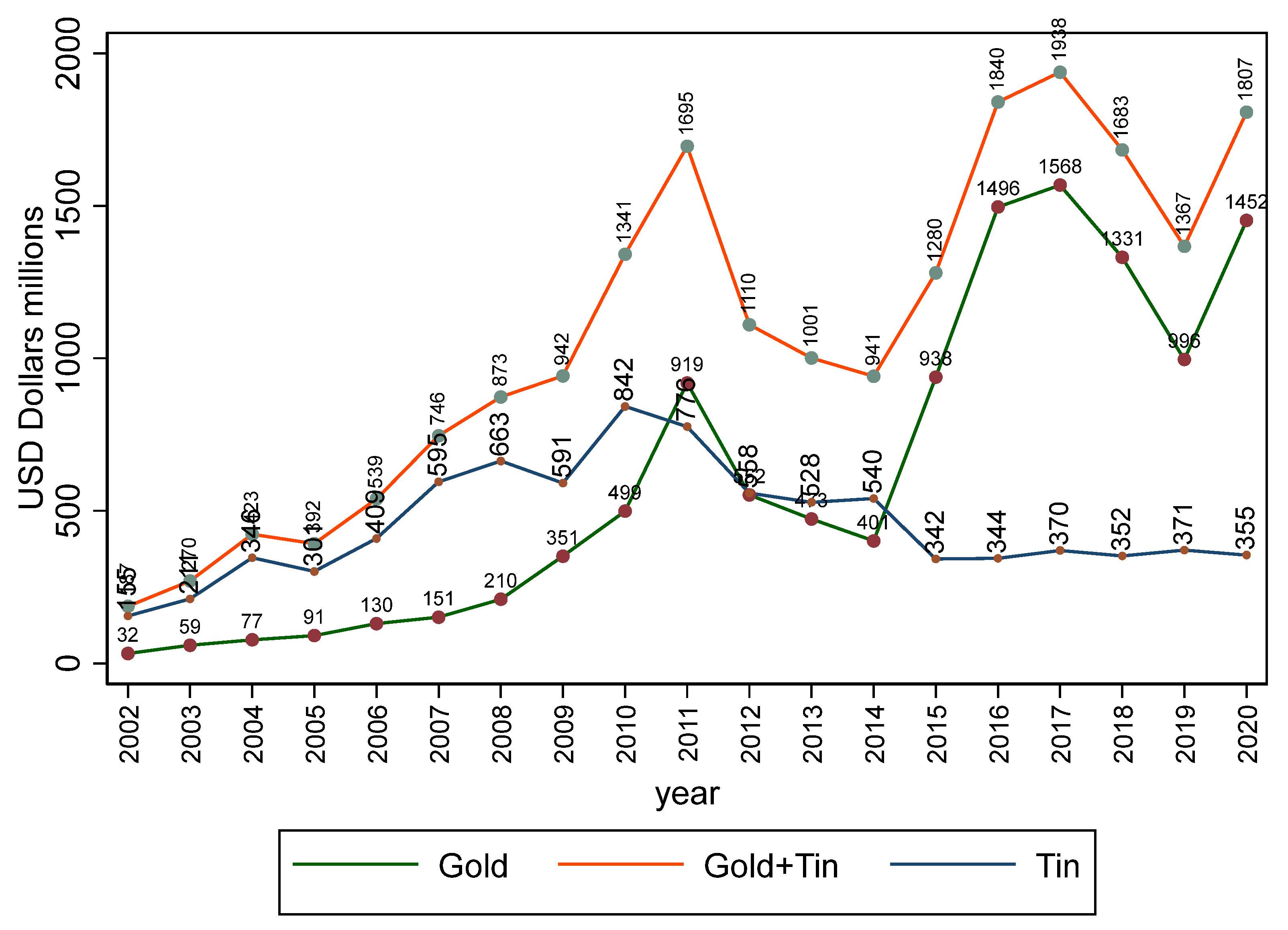Impact of Mining on Socioeconomic Status in Puno, Peru
Abstract
1. Introduction
2. Methodology
2.1. Random Effects Panel Data Model
2.2. Random Effects Panel Data Model
3. Data
4. Results and Discussion
4.1. Impact of Mining on Socioeconomic Indicators in the Long Term: 2003–2029
4.2. Impact of Mining on Socioeconomic Indicators in the Short Term: 2015–2019
5. Conclusions
6. Recommendations
Author Contributions
Funding
Institutional Review Board Statement
Informed Consent Statement
Data Availability Statement
Conflicts of Interest
References
- Rice, B.; Buller, A.M.; Boccia, D.; Bazán, C.; Miranda, R.; Cea, X.; Laro, R.; Fontes, M.; Hayes, R.; de Wit, M.; et al. Establishing the Health and Wellbeing Needs of Mining Host Community in Brazil, Chile and Peru: A Mixed-Method Approach to Identify Priority Areas for Action to Help Communities Meet Their SDG3 Targets. BMC Public Health 2023, 23, 2218. [Google Scholar] [CrossRef]
- Davis, K.F.; Akram, H.; Meydani, A.; Khan, B.; Ali, S.H. Socio-Ecological Tradeoffs Between Household Wealth and Water Stress in Global Mining Areas. 2024. Available online: https://www.researchsquare.com/article/rs-4438652/v1 (accessed on 25 May 2024).
- Muvuka, B. A Rapid Assessment of the Impacts of Gold Mining on Women’s Health and Quality of Life in Ashanti Region, Ghana. J. Public Health Issues Pract. 2019, 3, 138. [Google Scholar] [CrossRef]
- Leuenberger, A.; Winkler, M.S.; Cambaco, O.; Cossa, H.; Kihwele, F.; Lyatuu, I.; Zabré, H.R.; Farnham, A.; Macete, E.; Munguambe, K.; et al. Health Impacts of Industrial Mining on Surrounding Communities: Local Perspectives from Three Sub-Saharan African Countries. PLoS ONE 2021, 16, e0252433. [Google Scholar] [CrossRef]
- Xiao-jing, C.; Tan, X. How Does the Urban-Rural Income Disparity Affect Economic Growth? Acta Univ. Agric. Silvic. Mendel. Brun. 2017, 65, 245–257. [Google Scholar]
- Taylor, A.; Bonner, M.D. Policing Economic Growth: Mining, Protest, and State Discourse in Peru and Argentina. Lat. Am. Res. Rev. 2017, 52, 3–17. [Google Scholar] [CrossRef]
- Aromolaran, A.B. Does Increase in Women’s Income Relative to Men’s Income Increase Food Calorie Intake in Poor Households? Evidence From Nigeria. Agric. Econ. 2010, 41, 239–249. [Google Scholar] [CrossRef]
- Pearson, D.S.; Nyonna, D.; Kim, K.J. The Relationship Between Economic Freedom, State Growth and Foreign Direct Investment in US States. Int. J. Econ. Financ. 2012, 4, 140. [Google Scholar] [CrossRef]
- Boachie, M.K.; Ramu, K. Effect of Public Health Expenditure on Health Status in Ghana. Int. J. Health 2016, 4, 6. [Google Scholar] [CrossRef]
- Aragón, F.M.; Rud, J.P. Natural resources and local communities: Evidence from a peruvian gold mine. Am. Econ. J. Econ. Policy 2013, 5, 1–25. [Google Scholar] [CrossRef]
- Loayza, N.; Rigolini, J. The Local Impact of Mining on Poverty and Inequality: Evidence from the Commodity Boom in Peru. World Dev. 2016, 84, 219–234. [Google Scholar] [CrossRef]
- MINEM. Anuario 2019. Minesterio de Energia y Minas. 2019. Available online: https://www.gob.pe/institucion/minem/informes-publicaciones/1424993-anuario-minero-2019 (accessed on 15 May 2024).
- Swenson, J.J.; Carter, C.E.; Domec, J.C.; Delgado, C.I. Gold mining in the peruvian amazon: Global prices, deforestation, and mercury imports. PLoS ONE 2011, 6, e18875. [Google Scholar] [CrossRef]
- SUNAT-ADUANAS. Exportaciones de oro en las Demás Formas en Bruto del Perú (Partida 7108120000). Available online: https://www.siicex.gob.pe/siicex/portal5ES.asp?page=234.00000 (accessed on 24 June 2024).
- Al Rawashdeh, R.; Campbell, G.; Titi, A. The socio-economic impacts of mining on local communities: The case of Jordan. Extr. Ind. Soc. 2016, 3, 494–507. [Google Scholar] [CrossRef]
- Isung, C.B.; Salifu, Y.; Agana, T.A. The Socio-Economic Implications of Artisanal and Small-Scale Mining on Mining Communities in Northern Ghana. OAlib 2021, 08, 1–17. [Google Scholar] [CrossRef]
- Carpio, A.L.; Salcedo, Y.C. Mercurio en Un Arroyo Altoandino Con Alto Impacto Por Minería Aurífera Artesanal (La Rinconada, Puno, Perú). Rev. Int. Contam. Ambient. 2020, 36, 33–44. [Google Scholar] [CrossRef]
- Quiroz, C.J.C.; Choque, G.J.M.; Quispe, G.L.F.; Pajuelo, D.G.F.; Velarde, E.D.O.; Chiampo, F.; Carpio, M. Evaluation of Potentially Toxic Elements in Soil andPotential Ecological Risks Generated by Environmental Liabilities in Tacna, Peru. BioRxiv 2024, arXiv:2024.09.21.614289. [Google Scholar]
- Ticona, R.S.; Terán, R.M. Contaminación Minera Informal en El Derecho a La Vida. Rev. Cient. Andin. Sci. Humanit. 2023, 3, 281–294. [Google Scholar]
- Muriki, J.G.; Wambugu, S.K.; Obando, J.A. The Spatial Distribution of Quarry Stone Mining Sites in Igembe South Sub-County Meru County, Kenya. J. Humanit. Soc. Sci. 2023, 2, 120–129. [Google Scholar] [CrossRef]
- Cartolin, H.M.B.; Felix, M.H. Contamination of Natural Resources and Its Configuration of Environmental Crime in a High Andean Artisanal Mining, Apurimac, Perú. IOP Conf. Ser. Earth Env. Sci. 2023, 1236, 012002. [Google Scholar] [CrossRef]
- Mamani, E.Q.; Chura, F.F.C.; Avila, D.; Quispe, G.B. Imaginario Social De Actores Locales Sobre La Contaminación Ambiental Minera en El Altiplano Peruano. RCS 2022, 28, 303–321. [Google Scholar]
- Delgado, A.; Arroyo, E.; Rivera, B.; Pacheco, D.; Quispe, K.; Medina, M.; Colonia, A.; León, V. Applying Grey Systems to Determine if Mining Activity Is Main Factor of Water Pollution in Huallaga River in Peru. Int. J. Emerg. Technol. Adv. Eng. 2022, 12, 27–37. [Google Scholar] [CrossRef]
- Cacciuttolo, C.; Pulido, A.M. Experiences of Underground Mine Backfilling Using Mine Tailings Developed in the Andean Region of Peru: A Green Mining Solution to Reduce Socio-Environmental Impacts. Sustainability 2023, 15, 12912. [Google Scholar] [CrossRef]
- Nuryanty, C.D.; Riani, E.; Abidin, Z.; Sutjahjo, S.H.; Riyadi, A. Predictive Modelling of Mercury Pollution in Indonesian ASGM Areas and Evaluation of the Main Factors Using Machine Learning Algorithm. IOP Conf. Ser. Earth Environ. Sci. 2022, 1109, 012046. [Google Scholar] [CrossRef]
- D’souza, M.S.; Karkada, S.N.; Somayaji, G.; Venkatesaperumal, R. Women’s Well-Being and Reproductive Health in Indian Mining Community: Need for Empowerment. Reprod Health 2013, 10, 1–24. [Google Scholar] [CrossRef] [PubMed]
- Heemskerk, M.; Le Tourneau, F.-M.; Hiwat, H.; Cairo, H.; Pratley, P. In a Life Full of Risks, COVID-19 Makes Little Difference. Responses to COVID-19 Among Mobile Migrants in Gold Mining Areas in Suriname and French Guiana. Soc. Sci. Med. 2022, 296, 114747. [Google Scholar] [CrossRef]
- Chakuya, J. An Assessment of the Impact of Illegal Artisanal Gold Mining on the Environment in Parts of Chewore Safari Area, Northern Zimbabwe. Environ. Res. Commun. 2023, 5, 075005. [Google Scholar] [CrossRef]
- Stoll, E.; Roopsind, A.; Maharaj, G.; Velazco, S.; Caughlin, T.T. Detecting Gold Mining Impacts on Insect Biodiversity in a Tropical Mining Frontier with SmallSat Imagery. Remote Sens. Ecol. Conserv. 2022, 8, 379–390. [Google Scholar] [CrossRef]
- Meaza, H.; Ali, M.; Tesfamariam, Z.; Abebe, N. Impacts of Artisanal Gold Mining Systems on Soil and Woody Vegetation in the Semi-arid Environment of Northern Ethiopia. Singap. J. Trop. Geogr. 2017, 38, 386–401. [Google Scholar] [CrossRef]
- Shikhov, A. Satellite-Based Mapping of Gold-Mining-Related Land-Cover Changes in the Magadan Region, Northeast Russia. Remote Sens. 2023, 15, 3564. [Google Scholar] [CrossRef]
- Mestanza-Ramón, C.; Cuenca-Cumbicus, J.; D’Orio, G.; Flores-Toala, J.M.; Segovia-Cáceres, S.M.; Bonilla-Bonilla, A.E.; Straface, S. Gold Mining in the Amazon Region of Ecuador: History and a Review of Its Socio-Environmental Impacts. Land 2022, 11, 221. [Google Scholar] [CrossRef]
- Diogens, C.J.; Nääs, I.d.A.; Benvenga, M.A.C. The Impact of Gold Mining on Regional Development in Brazil. Eur. J. Sustain. Dev. Res. 2024, 8, em0256. [Google Scholar] [CrossRef]
- Hilmawan, R.; Amalia, S. Coal and Mineral and Its Impact on Human Development Index: An Empirical Study in South and East Kalimantan Region, Indonesia. Int. J. Energy Econ. Policy 2020, 10, 488–494. [Google Scholar] [CrossRef]
- Warner, D.C.; Rao, D.S.P.; Griffiths, W.E.; Chotikapanich, D. Global Inequality; Levels and Trends, 1993–2005: How Sensitive Are These to the Choice of PPP s and Real Income Measures? Rev. Income Wealth 2014, 60, S281–S304. [Google Scholar] [CrossRef]
- Afkarina, K.I.I.; Wardana, S.; Damayanti, P. Coal Mining Sector Contribution to Environmental Conditions and Human Development Index in East Kalimantan Province. J. Environ. Sci. Sustain. Dev. 2019, 2, 6. [Google Scholar] [CrossRef]
- Arellano, M. Panel Data Econometrics; Advanced Texts in Econometrics; OUP Oxford University Press: Oxford, UK, 2003; Available online: https://global.oup.com/academic/product/panel-data-econometrics-9780199245291?cc=pe&lang=en& (accessed on 25 May 2024).
- Bernal, R.S.; Peña, X. Guía Práctica Para la Evaluación de Impacto; Uniandes, E., Ed.; Facutad de Economía, Centro de Estudios sobre Desarrollo Económico; Universidad de los Andes: Bogota, Colombia, 2011; p. 325. Available online: http://www.scielo.org.co/scielo.php?script=sci_arttext&pid=S0120-35842010000200007 (accessed on 25 May 2024).
- UNDP. Human Development Index—HDI. Instituto Peurano de Economia. 2021. Available online: https://ipe.org.pe/indice-de-desarrollo-humano-idh/ (accessed on 20 June 2024).
- Abadie, A.; Cattaneo, M.D. Econometric Methods for Program Evaluation. Annu. Rev. Econ. 2018, 10, 465–503. [Google Scholar] [CrossRef]
- Dorin, I.; Diaconescu, C.; Topor, D.I. The Role of Mining in National Economies. Int. J. Acad. Res. Account. Financ. Manag. Sci. 2014, 4, 155–160. [Google Scholar] [CrossRef]
- Frederiksen, A.; Centerpark, B. Mining in Arctic and Non-Arctic Regions: A Socioeconomic Assessment. SSRN Electron. J. 2016, 9883. [Google Scholar] [CrossRef]
- Moritz, T.; Ejdemo, T.; Söderholm, P.; Wårell, L. The Local Employment Impacts of Mining: An Econometric Analysis of Job Multipliers in Northern Sweden. Miner. Econ. 2017, 30, 53–65. [Google Scholar] [CrossRef]
- Gochero, P.; Seetanah, B. The Effect of Mining Foreign Direct Investment Inflow on the Economic Growth of Zimbabwe. J. Econ. Struct. 2020, 9, 54. [Google Scholar] [CrossRef]
- Wang, C.; Wang, L.; Xue, Y.; Li, R. Revealing Spatial Spillover Effect in High-Tech Industry Agglomeration from a High-Skilled Labor Flow Network Perspective. J. Syst. Sci. Complex. 2021, 35, 839–859. [Google Scholar] [CrossRef]
- Wang, X.; Fang, H.; Zhang, F.; Fang, S. The Spatial Analysis of Regional Innovation Performance and Industry-University-Research Institution Collaborative Innovation—An Empirical Study of Chinese Provincial Data. Sustainability 2018, 10, 1243. [Google Scholar] [CrossRef]
- Ncanywa, T. Economic Activities of Mining Production and Agricultural Economic Growth in South Africa. J. Rev. Glob. Econ. 2019, 8, 1289–1297. [Google Scholar] [CrossRef]
- Mancini, L.; Sala, S. Social impact assessment in the mining sector: Review and comparison of indicators frameworks. Resour. Policy 2018, 57, 98–111. [Google Scholar] [CrossRef]
- Zeng, X.; Liu, Z.; He, C.; Ma, Q.; Wu, J. Quantifying Surface Coal-Mining Patterns to Promote Regional Sustainability in Ordos, Inner Mongolia. Sustainability 2018, 10, 1135. [Google Scholar] [CrossRef]
- Broadberry, S.; Irwin, D.A. Lost Exceptionalism? Comparative Income and Productivity in Australia and the UK, 1861–1948. Econ. Rec. 2007, 83, 262–274. [Google Scholar] [CrossRef]
- Yamada, G.; Molina, O.; Velásquez, D. Mining and Human Capital Accumulation: The Role of the Return to Education; Working Paper No. 135; PERUVIAN ECONOMIC ASSOCIATION, 2018. [Google Scholar]
- Bishop, J. Education Choices and Labour Supply During the Mining Boom. RBA Bull. 2019, 20–27. [Google Scholar]
- Sher, L. Per Capita Income Is Related to Suicide Rates in Men but Not in Women. J. Men’s Health Gend. 2006, 3, 39–42. [Google Scholar] [CrossRef]
- Ahlerup, P.; Baskaran, T.; Bigsten, A.; Ahlerup, P.; Baskaran, T.; Bigsten, A. Gold mining and education: A long-run resource curse in Africa? Gold mining and education: A long-run resource curse in Africa? J. Dev. Stud. 2016, 2473, 666. [Google Scholar]
- Owusu, S.A.; Afrifa, R.D.; Obeng, F.A. Effect of illegal small-scale mining on basic education of children in rural communities in Ghana: Perspectives for future development. Afr. Geogr. Rev. 2021, 41, 336–349. [Google Scholar] [CrossRef]
- Ruijven, B.v.; Cian, E.D.; Wing, I.S. Amplification of Future Energy Demand Growth Due to Climate Change. Nat. Commun. 2019, 10, 2762. [Google Scholar] [CrossRef]
- Zullig, K.J.; Hendryx, M. A Comparative Analysis of Health-Related Quality of Life for Residents of U.S. Counties With and Without Coal Mining. Public Health Rep. 2010, 125, 548–555. [Google Scholar] [CrossRef]
- Frantál, B.; Nováková, E. A Curse of Coal? Exploring Unintended Regional Consequences of Coal Energy in the Czech Republic. Morav. Geogr. Rep. 2014, 22, 55–65. [Google Scholar] [CrossRef]
- Wagenius, C.M.; Sebastián, M.S.; Gustafsson, P.E.; Goicolea, I. Access for All? Assessing Vertical and Horizontal Inequities in Healthcare Utilization Among Young People in Northern Sweden. Scand. J. Public Health 2018, 47, 1–8. [Google Scholar] [CrossRef]
- Singh, G. Estimating Optimal Hedge Ratio and Hedging Effectiveness in the NSE Index Futures. Jindal J. Bus. Res. 2017, 6, 108–131. [Google Scholar] [CrossRef]
- Locke, C. Frac Sand Mines Are Preferentially Sited in Unzoned Rural Areas. PLoS ONE 2015, 10, e0131386. [Google Scholar] [CrossRef] [PubMed]
- Yazici, M.; Islam, M.Q. Determinants of Turkish Mining Trade Balance With Eu(15): Estimates from Bound Testing Approach. Pressacademia 2016, 5, 233. [Google Scholar] [CrossRef]
- Zengarini, N.; Ponti, A.; Tomatis, M.; Casella, D.; Giordano, L.; Mano, M.P.; Segnan, N.; Whitehead, M.; Costa, G.; Spadea, T. Absence of Socioeconomic Inequalities in Access to Good-Quality Breast Cancer Treatment Within a Population-Wide Screening Programme in Turin (Italy). Eur. J. Cancer Prev. 2016, 25, 538–546. [Google Scholar] [CrossRef] [PubMed]
- Mikami, S.; Ito, Y.; Gonzales, H.G.O. Assessing Peruvian University Students’ Preferences for Labor Conditions in Mining Site. Sustainability 2021, 13, 9648. [Google Scholar] [CrossRef]
- Sánchez, T.; Espinoza-Culupú, A.; Ramírez, P.; Iwai, L.K.; Montoni, F.; Macedo-Prada, D.; Sulca-López, M.; Sulca-López, Y.; Farfán-López, M.; Farfán-López, J. Proteomic Study of Response to Copper, Cadmium, and Chrome Ion Stress in Yarrowia Lipolytica Strains Isolated from Andean Mine Tailings in Peru. Microorganisms 2022, 10, 2002. [Google Scholar] [CrossRef]
- Vallejos, P.Q.; Veit, P.; Tipula, P.; Reytar, K. Undermining Rights: Indigenous Lands and Mining in the Amazon. Wripub 2020, 132. [Google Scholar]
- Benites, G.V.; Bebbington, A. Political Settlements and The Governance of COVID-19: Mining, Risk, And Territorial Control in Peru. J. Lat. Am. Geogr. 2020, 19, 215–223. [Google Scholar] [CrossRef]
- Armstrong, R.; Baillie, C.; Fourie, A.; Rondon, G. Mines and Community Engagement in Peru: Communities Telling Their Stories to Improve Future Practice; 2020; pp. 7–51. Available online: https://ouci.dntb.gov.ua/en/works/4NrdEbK4/ (accessed on 25 May 2024).
- Araujo, L.R.C. Capital Humano, Programas Sociales Y Desarrollo. El Caso Del Programa Tekoporã en Yuty, Caazapá, Paraguay. Kera Yvoty Reflex. Sobre Cuestión Soc. 2023, 8, 1–22. [Google Scholar] [CrossRef]
- Nenci, S.; Quatraro, F. Innovation and Competitiveness in Mining Value Chains in Latin America. 2021. Available online: https://publications.iadb.org/en/innovation-and-competitiveness-mining-value-chains-latin-america (accessed on 25 May 2024).
- Sáenz, C.; Ostos, J. Corporate Social Responsibility Supports the Construction of a Strong Social Capital in the Mining Context: Evidence from Peru. J. Clean. Prod. 2020, 267, 122162. [Google Scholar] [CrossRef]

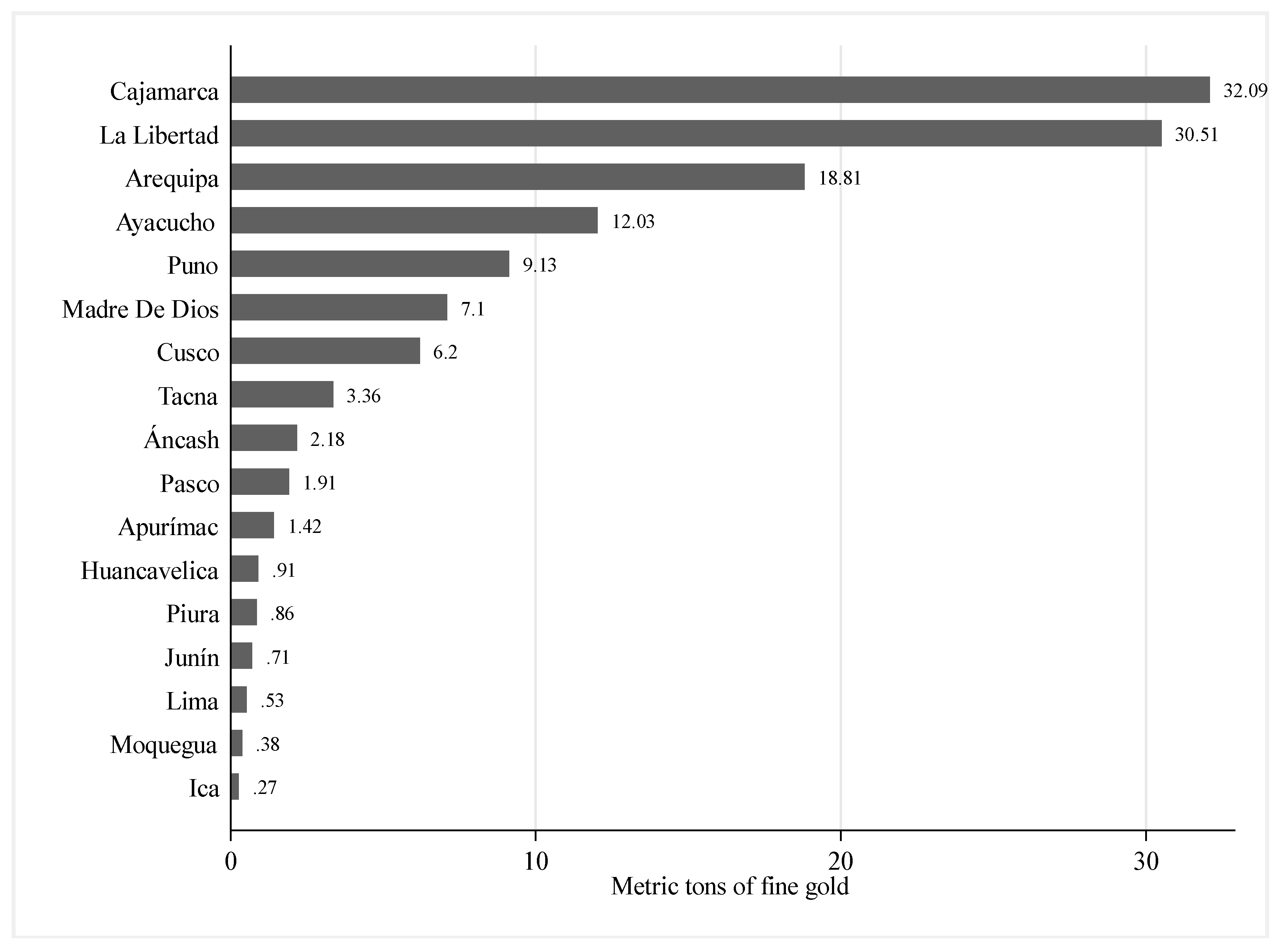
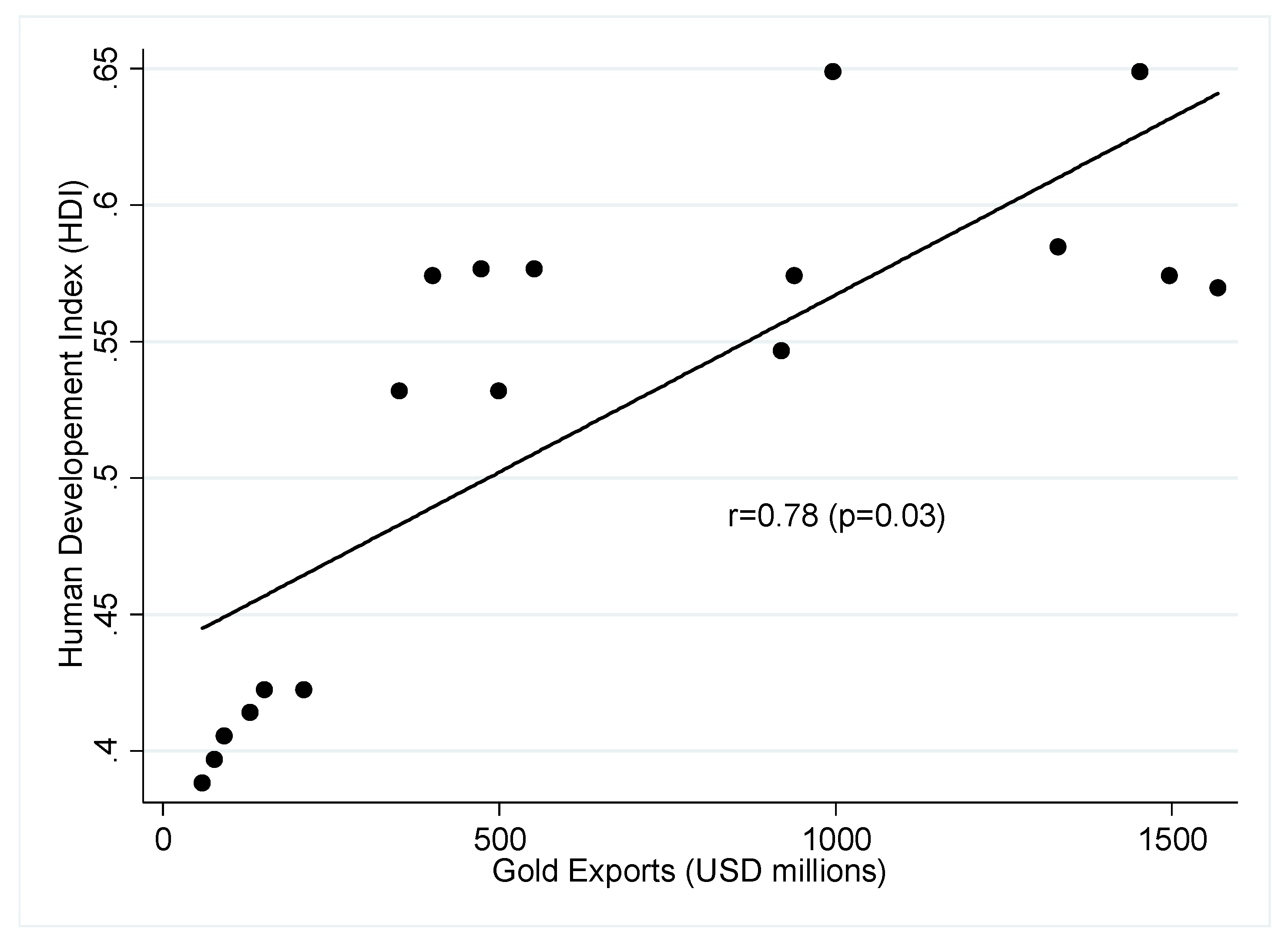
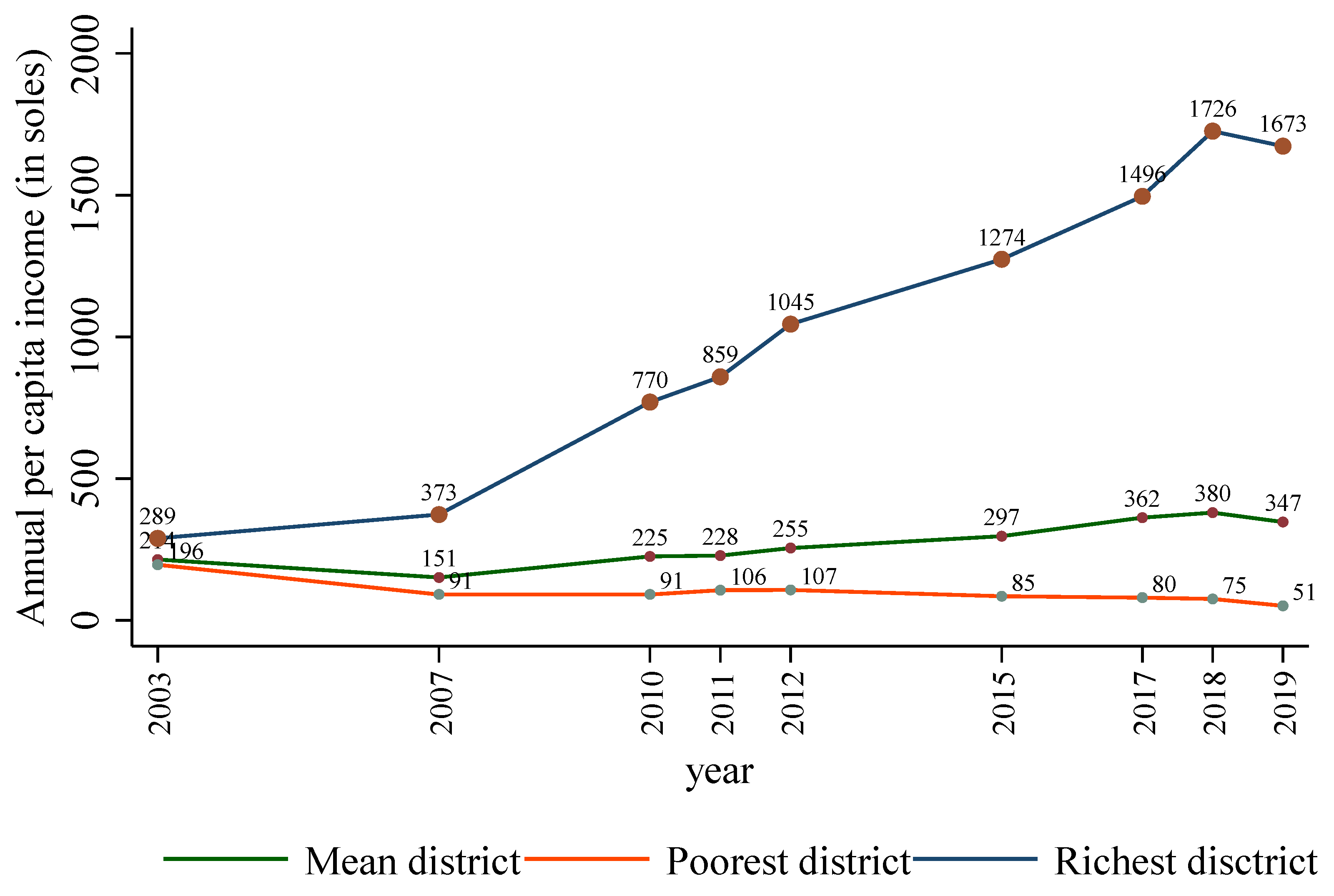

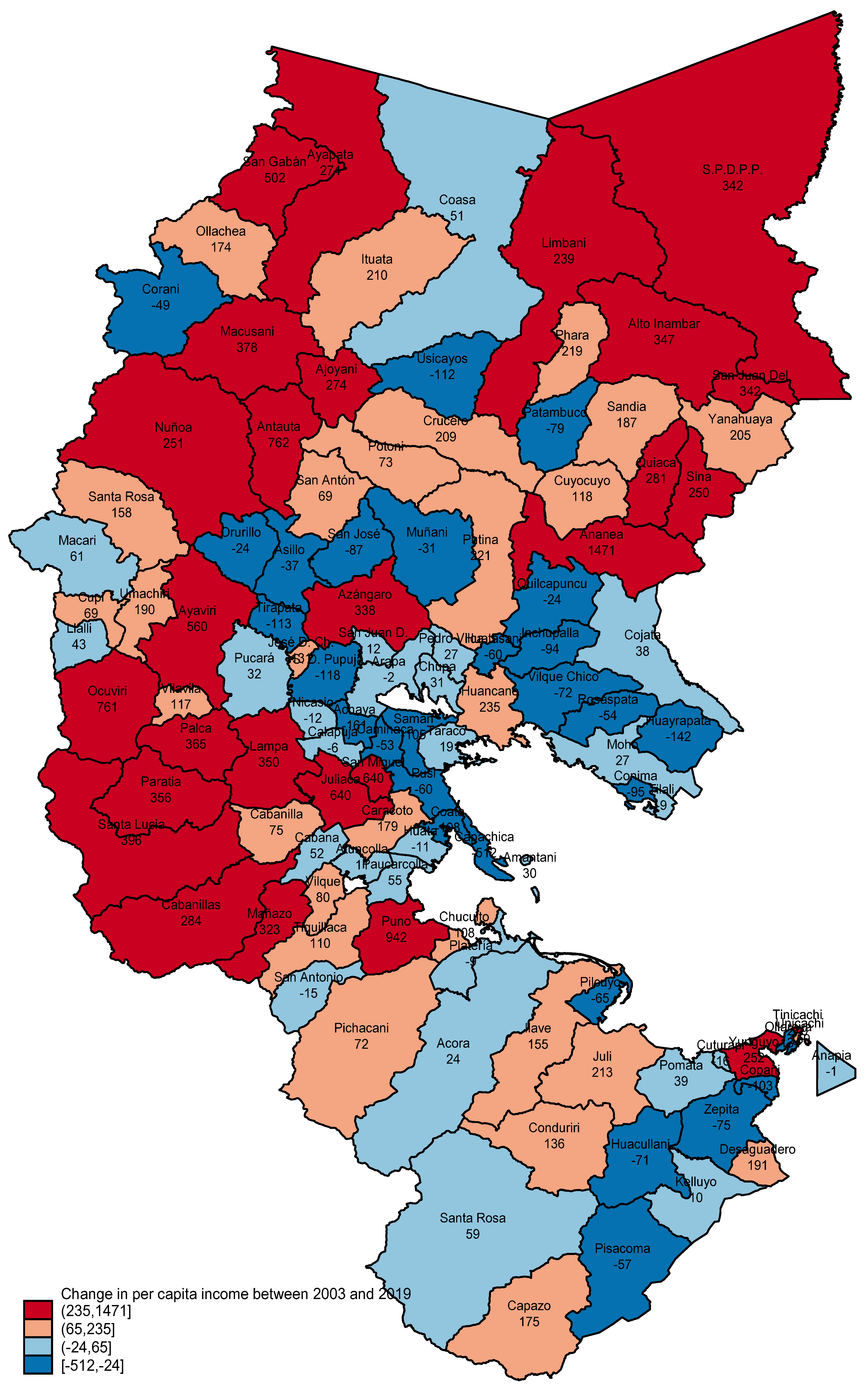
| Notation | Variable | 2003 | 2019 | ||||
|---|---|---|---|---|---|---|---|
| Mean | Min. | Max. | Mean | Min. | Max. | ||
| IDH | Human Development Index | 0.26 | 0.18 | 0.38 | 0.34 | 0.13 | 0.64 |
| y1 | Per capita household income at the district level | 214 | 196 | 289 | 347 | 51.1 | 1673 |
| y2 | Percentage of the 18-year-old population with completed secondary school | 54 | 15 | 87 | 68 | 46 | 85 |
| y3 | Years of education of the population ≥ 25 years | 5.3 | 3.6 | 11.2 | 6.4 | 4.2 | 11.7 |
| D | Dichotomous variable that identifies the mining-producing district | 0.14 | 0 | 1 | 0.14 | 0 | 1 |
| T | Dichotomous variable that identifies the year of impact evaluation | 0 | 0 | 0 | 1 | 1 | 1 |
| DT | Interaction variable between D and T | 0 | 0 | 0 | 0.14 | 0 | 1 |
| Variable | Parameter | Family Income per Capita | Percentage of 18-Year-Old Population with Secondary Education | HDI |
|---|---|---|---|---|
| Constant | 215.72 *** | 58.12 *** | 0.26 *** | |
| 0.00 | 0.00 | 0.00 | ||
| Mining district (D1) | −5.97 | −10.09 *** | −0.01 | |
| 0.89 | 0.00 | 0.54 | ||
| Non-mining district of the mining province (D2) | −1.72 | −8.67 *** | −0.01 | |
| 0.92 | 0.00 | 0.31 | ||
| Year (T) | 25.51 | 9.71 | 0.03 *** | |
| 0.363 | 0.00 | 0.00 | ||
| Direct impact on the mining district (D1T) | 239.44 *** | 12.27 ** | 0.09 ** | |
| 0.00 | 0.01 | 0.00 | ||
| Direct impact on the non-mining district of the mining province (D2T) | −26.34 | 9.71 | 0.02 | |
| 0.65 | 0.012 | 0.29 | ||
| Indirect impact on the mining district (D1TW) | −35.93 | −3.47 | 0.003 | |
| 0.75 | 0.67 | 0.92 | ||
| Indirect impact on the non-mining district of the mining province (D2TW) | 352.30 *** | 0.79 | 0.08 *** | |
| 0.00 | 0.88 | 0.00 | ||
| Spatial lag (We) | 0.98 | 0.42 *** | 0.41 *** | |
| 0.98 | 0.00 | 0.0 | ||
| Total impact | ||||
| Total impact on the mining district | + | 211.37 *** | 9.55 | 0.10 ** |
| 0.00 | 0.128 | 0.00 | ||
| Total impact on the non-mining district of the mining province | + | 248.83 *** | 10.14 ** | 0.10 * |
| constant | 0.00 | 0.32 | 0.00 | |
| Sigma_u | 36.39 | 6.44 *** | 0.04 *** | |
| 27.78 | 0.90 | 0.00 | ||
| Sigma_e | 140.49 *** | 8.42 *** | 0.46 | |
| 9.57 | 0.57 | 0.00 | ||
| Number of obs | 216 | 216 | 216 | |
| Number of groups | 108 | 108 | 108 | |
| Obs per group | 2 | 2 | 2 | |
| Wald chi2 | 110.71 | 75.05 | 112.04 | |
| Prob > chi2 | 0.00 | 0.00 | 0.00 | |
| Log likelihood | −1382 | −811.47 | 303.11 | |
| Pseudo R2 | 0.37 | 0.34 | 0.40 | |
| Wald test of spatial terms | ||||
| chi2(3) | 20.93 | 8.75 | 17.5 | |
| Prob > chi2 | 0.00 | 0.03 | 0.00 |
| Variable | Parameter | Family Income per Capita | Percentage of 18-Year-Old Population with Secondary Education | HDI |
|---|---|---|---|---|
| Constant | 245.78 *** | 62.42 *** | 0.29 *** | |
| 0.00 | 0.00 | 0.00 | ||
| Mining district (D1) | 236.54 *** | −5.72 ** | −0.084 *** | |
| 0.00 | 0.036 | 0.000 | ||
| Non-mining district of the mining province (D2) | 69.89 * | −4.86 ** | −0.03 *** | |
| 0.098 | 0.019 | 0.000 | ||
| Year (T) | 15.53 * | 5.48 *** | 0.013 *** | |
| 0.059 | 0.00 | 0.000 | ||
| Direct impact on the mining district (D1T) | 65.03 *** | 6.74 ** | 0.022 ** | |
| 0.005 | 0.016 | 0.012 | ||
| Direct impact on the non-mining district of the mining province (D2T) | −1.53 | 5.19 ** | 0.007 | |
| 0.09 | 0.013 | 0.27 | ||
| Indirect impact on the mining district (D1TW) | −7.27 | −0.26 | 0.010 | |
| −0.23 | 0.96 | 0.49 | ||
| Indirect impact on the non-mining district of the mining province (D2TW) | 80.59 *** | 0.34 | 0.03 *** | |
| 0.00 | 0.92 | 0.005 | ||
| Spatial lag (We) | 0.288 | 0.46 *** | 0.31 * | |
| 1.55 | 0.005 | 0.064 | ||
| Total impact | ||||
| Total impact on the mining district | + | 57.75 *** | 6.53 * | 0.03 ** |
| 0.00 | 0.085 | 0.004 | ||
| Total impact on the non-mining district of the mining province | + | 79.06 *** | 5.46 * | 0.03 *** |
| Constant | 0.00 | 0.053 | 0.000 | |
| Sigma_u | 184.60 *** | 6.44 *** | 0.078 *** | |
| 12.78 | 0.90 | 0.00 | ||
| Sigma_e | 36.04 *** | 8.42 *** | 0.013 *** | |
| 2.45 | 0.57 | 0.00 | ||
| Number of obs | 218 | 218 | 218 | |
| Number of groups | 109 | 109 | 109 | |
| Obs per group | 2 | 2 | 2 | |
| Wald chi2 | 119.05 | 75.52 | 160.22 | |
| Prob > chi2 | 0.000 | 0.00 | 0.00 | |
| Log likelihood | −1308 | −739.13 | 394.91 | |
| Pseudo R2 | 0.23 | 0.21 | 0.20 | |
| Wald test of spatial terms | ||||
| chi2(3) | 12.67 | 8.54 | 10.13 | |
| Prob > chi2 | 0.005 | 0.03 | 0.017 |
| Variation in per Capita Income | Stratum | Number of Districts | Percent | Predominant Sectors |
|---|---|---|---|---|
| (235, 1471 | 1 | 27 | 24.55% | Mining, trade, agriculture |
| (65, 235] | 2 | 28 | 25.45% | Agriculture and trade |
| (−24, 65] | 3 | 13 | 11.82% | Agriculture |
| (−512. −24] | 4 | 42 | 38.18% | Agriculture |
| Total | 110 | 100.00% |
Disclaimer/Publisher’s Note: The statements, opinions and data contained in all publications are solely those of the individual author(s) and contributor(s) and not of MDPI and/or the editor(s). MDPI and/or the editor(s) disclaim responsibility for any injury to people or property resulting from any ideas, methods, instructions or products referred to in the content. |
© 2025 by the authors. Licensee MDPI, Basel, Switzerland. This article is an open access article distributed under the terms and conditions of the Creative Commons Attribution (CC BY) license (https://creativecommons.org/licenses/by/4.0/).
Share and Cite
Paredes, R.P.; Arpi, R.; Vilca Huayta, O.A.; Chavez Flores, R.; Sucari Turpo, H.; Alfaro-Alejo, R.; Huamani, A.; Saravia, H. Impact of Mining on Socioeconomic Status in Puno, Peru. Sustainability 2025, 17, 9951. https://doi.org/10.3390/su17229951
Paredes RP, Arpi R, Vilca Huayta OA, Chavez Flores R, Sucari Turpo H, Alfaro-Alejo R, Huamani A, Saravia H. Impact of Mining on Socioeconomic Status in Puno, Peru. Sustainability. 2025; 17(22):9951. https://doi.org/10.3390/su17229951
Chicago/Turabian StyleParedes, Rene Paz, Roberto Arpi, Oliver Amadeo Vilca Huayta, Roberto Chavez Flores, Henry Sucari Turpo, Roberto Alfaro-Alejo, Alcides Huamani, and Hernan Saravia. 2025. "Impact of Mining on Socioeconomic Status in Puno, Peru" Sustainability 17, no. 22: 9951. https://doi.org/10.3390/su17229951
APA StyleParedes, R. P., Arpi, R., Vilca Huayta, O. A., Chavez Flores, R., Sucari Turpo, H., Alfaro-Alejo, R., Huamani, A., & Saravia, H. (2025). Impact of Mining on Socioeconomic Status in Puno, Peru. Sustainability, 17(22), 9951. https://doi.org/10.3390/su17229951





